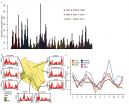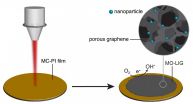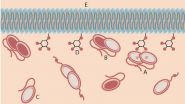(Press-News.org) Children who have been abused or exposed to other types of trauma typically experience more intense emotions than their peers, a byproduct of living in volatile, dangerous environments.
But what if those kids could regulate their emotions? Could that better help them cope with difficult situations? Would it impact how effective therapy might be for them?
A University of Washington-led team of researchers sought to address those questions by studying what happens in the brains of maltreated adolescents when they viewed emotional images, and then tried to control their responses to them. The researchers found that with a little guidance, maltreated children have a surprising ability to regulate their emotions.
"They were just as able to modulate their emotional responses when they were taught strategies for doing so," said Kate McLaughlin, a UW assistant professor of psychology and the study's lead author. "That's very encouraging."
Difficulties with regulating emotions are linked to the onset of mental disorders among maltreated children. Previous research has focused on how the brains of such children respond spontaneously to negative facial emotions, but the UW study, published Aug. 20 in the Journal of the American Academy of Child & Adolescent Psychiatry, is thought to be the first looking at whether maltreatment impacts brain regions involved in emotion control.
The study involved 42 boys and girls age 13 to 19, half of whom had been physically and/or sexually abused. Using magnetic resonance imaging, the researchers tracked the teens' brain activity as they were shown a series of photographs.
The teens were first shown neutral, positive and negative images and were told to let their emotions unfold naturally. The neutral images featured outdoor scenes or objects, such as a coffee cup or a pair of glasses, while the positive and negative images depicted scenarios showing people with different facial expressions -- a smiling family engaged in a fun activity, for example, or two people arguing. The exercise was intended to model real-world emotional situations, McLaughlin said.
"How much do you react when something emotional happens? Some people have really strong emotional reactions. Some people have much more muted responses," said McLaughlin, director of the UW's Stress & Development Laboratory.
"The question is, do we see differences in the brain in terms of how it responds to emotional information in kids who have been maltreated?"
The answer is yes, the researchers concluded. The positive images generated little difference in brain activity between the two groups. But when looking at negative images, the maltreated teens had more activity in brain regions involved in identifying potential threats -- including the amygdala, which plays a key role in processing emotions and learning about environmental threats -- than the control group. That makes sense, McLaughlin said, since in a chronically dangerous environment the brain is on heightened alert, constantly on the lookout for potential threats.
In a second exercise, participants were shown more photos and told to try to increase their emotional responses to the positive images and scale them back when viewing the negative images, using techniques they were taught beforehand. The children were shown how to use cognitive reappraisal, a strategy that involves thinking about a situation differently to alter the emotional response to it.
Participants thought about the negative images in ways that made them psychologically more distant -- for example, thinking that the people in the photos were strangers or that the scene was not really happening. For the positive cues, they thought about the images in a way that made them more realistic, such as imagining that they were part of the happy scene or that it involved people they knew.
Again, the two groups were similar in their brain responses to the positive images. But the negative photos caused the maltreated teens' brains to go into overdrive, drawing more heavily on regions in the prefrontal cortex to tamp down their feelings. The prefrontal cortex is involved in higher-order cognition and integrates information from other areas of the brain to effectively control emotions and behaviors and guide decision-making.
Though it was more difficult for them, the maltreated teens were able to modulate activity in the amygdala just as well as the participants with no history of maltreatment. That suggests that given the right tools, maltreated children may be able to control their emotional responses to real-world situations.
It also has promising implications for treatment, McLaughlin said, since the strategies participants used in the study are similar to those used in trauma therapy. Specifically, cognitive reappraisal, the strategy children used to regulate their emotions in the study, is a core technique used in trauma-focused treatments for children.
There's a common assumption that children subjected to abuse or trauma will have problematic emotions across the board, McLaughlin said -- muted responses to positive situations and extreme reactions to negative ones. But the study's findings suggest that maltreated children are perhaps more resilient and adaptable than previously thought.
"It seems that they are able to cope effectively, even in very stimulating emotional situations, if they're taught strategies for doing so," she said. "We think the findings are really promising."
INFORMATION:
The research was funded by the National Institutes of Health and the Charles H. Hood Foundation. Co-authors are UW psychology graduate student Matthew Peverill, Andrea Gold of the National Institute of Mental Health, Sonia Alves of Harvard University and Boston Children's Hospital, and Margaret Sheridan of Harvard University.
For more information, contact McLaughlin at mclaughk@uw.edu or 860-930-8246. For a copy of the study, contact Deborah Bach at bach2@uw.edu or 206-543-2580.
FROM: Deborah Bach
University of Washington
206-543-2580
bach2@uw.edu
PRINCETON, N.J.--Tracking mobile phone data is often associated with privacy issues, but these vast datasets could be the key to understanding how infectious diseases are spread seasonally, according to a study published in the Proceedings of the National Academy of Sciences.
Princeton University and Harvard University researchers used anonymous mobile phone records for more than 15 million people to track the spread of rubella in Kenya and were able to quantitatively show for the first time that mobile phone data can predict seasonal disease patterns.
Harnessing ...
Glenview, Ill. (August 20, 2015)--The popularity of electronic cigarettes has steadily increased worldwide, but little is known about their effects on health. New research suggests that the single use of an electronic cigarette approximating the nicotine exposure of one tobacco cigarette reduces the sensitivity of the cough reflex.
The study tested 30 adult lifetime nonsmokers with no history of asthma or respiratory diseases and used cough tests to determine how e-cigarettes affect the cough reflex. Capsaicin, the pungent extract of red peppers, was used to induce a ...
Medicaid is expected to save billions of dollars a year as patents for several blockbuster antipsychotic medications expire and use of generic versions of these drugs increases, according to a new study by researchers at the University of Maryland School of Medicine. These savings may provide relief from the high costs of these medications and allow policymakers to lift restrictions on patients' access, the researchers argue.
The study forecast that annual Medicaid payments for antipsychotic medicines will decrease by nearly $1.8 billion (or nearly 50 percent) by 2016 ...
HOUSTON - (Aug. 20, 2015) - Rice University chemists who developed a unique form of graphene have found a way to embed metallic nanoparticles that turn the material into a useful catalyst for fuel cells and other applications.
Laser-induced graphene, created by the Rice lab of chemist James Tour last year, is a flexible film with a surface of porous graphene made by exposing a common plastic known as polyimide to a commercial laser-scribing beam. The researchers have now found a way to enhance the product with reactive metals.
The research appears this month in the ...
Leading scientists and experts in the field of rhino conservation state in a new paper that it is safe to consider the Sumatran rhinoceros extinct in the wild in Malaysia. The survival of the Sumatran rhino now depends on the 100 or fewer remaining individuals in the wild in Indonesia and the nine rhinos in captivity.
Despite intensive survey efforts, there have been no signs of the wild Sumatran rhinoceros (Dicerorhinus sumatrensis) in Malaysia since 2007, apart from two females that were captured for breeding purposes in 2011 and 2014. Scientists now consider the species ...
An international team of scientists headed by biologists at UC San Diego has discovered that an important class of stem cells known as human "induced pluripotent stem cells," or iPSCs, which are derived from an individual's own cells, can be differentiated into various types of functional cells with different fates of immune rejection.
The scientists also found that these cells may not be rejected by the immune system if iPSCs are turned into retinal pigment epithelium cells destined for the eye.
Their discovery provides hope for the development of human stem cell therapies ...
A team of Swiss geneticists from the University of Geneva (UNIGE), the École Polytechnique Fédérale de Lausanne (EPFL), and the University of Lausanne (UNIL) discovered that genetic variation has the potential to affect the state of the genome at many, seemingly separated, positions and thus modulate gene activity, much like a conductor directing the performers of a musical ensemble to play in harmony. These unexpected results, published in Cell, reveal the versatility of genome regulation and offer insights into the way it is orchestrated.
Chromatin, a ...
An international group of researchers led by Carnegie Mellon University physicists Mathias Lösche and Frank Heinrich have established the structure of an important tumor suppressing protein, PTEN. Their findings provide new insights into how the protein regulates cell growth and how mutations in the gene that encodes the protein can lead to cancer. The study is published online in Structure, and will appear in the Oct. 6 issue.
Phosphatase and tensin homolog (PTEN) is a known tumor suppressing protein that is encoded by the PTEN gene. When expressed normally, the ...
The hippocampus in the brain's temporal lobe is responsible for more than just long-term memory. Researchers have for the first time demonstrated that it is also involved in quick and successful conflict resolution. The team headed by Prof Dr Nikolai Axmacher from the Ruhr-Universität Bochum (RUB), together with colleagues from the University Hospital of Bonn as well as in Aachen and Birmingham, reported in the journal "Current Biology".
Decision conflicts occur often in everyday life
In their everyday life, people are constantly confronted with decision conflicts, ...
Researchers estimate the 20-year breast cancer-specific death rate for women diagnosed with ductal carcinoma in situ to be 3.3 percent, although the death rate is higher for women diagnosed before age 35 and for black women, according to an article published online by JAMA Oncology.
Ductal carcinoma in situ breast (DCIS) cancer, which is also referred to as stage 0 breast cancer, accounts for about 20 percent of the breast cancers detected through mammography. Some women with DCIS experience a second breast cancer (DCIS or invasive) and a small proportion of patients ...



